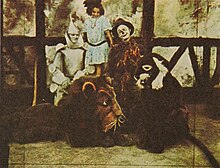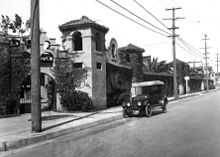Selig Polyscope Company
 | |
| Industry | Entertainment |
|---|---|
| Founded | 1896 |
| Defunct | 1918 |
| Headquarters | , United States |
| Products | Motion pictures |
| Owner | William Selig |
TheSelig Polyscope Companywas an Americanmotion picturecompany that was founded in 1896 byWilliam SeliginChicago,Illinois.[1]The company produced hundreds of early, widely distributed commercial moving pictures, including the first films starringTom Mix,Harold Lloyd,Colleen Moore,andRoscoe "Fatty" Arbuckle.Selig Polyscope also establishedSouthern California's first permanent movie studio, in the historicEdendale districtof Los Angeles.[2]
Ending film production in 1918, the business, which had become known for its film production animals, became an animal and prop supplier to other studios and azooand amusement park attraction inEast Los Angeles.The amusement park and zoo went into decline during theGreat Depressionin the 1930s.[3]
In 1947, William Selig and several other early movie producers and directors shared a specialAcademy Honorary Awardto acknowledge their role in building the film industry.[4]
History
[edit]

William Selig initially worked as amagicianandminstrel showoperator on the west coast inCalifornia.[5]Later on, while living inChicago,he entered the film business using his own photographic equipment, free from thepatentrestrictions that were imposed through companies controlled byThomas Edison.In 1896, with help from Union Metal Works and Andrew Schustek, he shot his first film,Tramp and the Dog.
He then went on to successfully produce local actualities,slapstickcomedies, earlytraveloguesandindustrial films(a major client wasArmour and Company). In 1908, Selig Polyscope was involved in the production ofThe Fairylogue and Radio-Plays,a touring "multimedia" attempt to bringL. Frank Baum'sOz booksto a wider public (which played to full houses but was nonetheless a financial disaster for Baum).
By 1909, Selig had studios making short features in Chicago and theEdendale district of Los Angeles.The company also distributed stock film footage and titles from other studios. That year,Roscoe Arbuckle's first movie was a Selig comedy short.
The company's early existence was fraught with legal turmoil over disputes with lawyers representingThomas Edison's interests. In 1909, Selig and several other studio heads settled with Edison by creating an alliance with the inventor. Effectively acartel,Motion Picture Patents Companydominated the industry for a few years until theSupreme Court(in 1913 and 1915) ruled the firm was an illegalmonopoly.
In 1910, Selig Polyscope produced a wholly new filmed version ofThe Wonderful Wizard of Oz.The company produced the first commercial two-reel film,Damon and Pythias,successfully distributed its pictures in Great Britain, and maintained an office in London for several years before the outbreak ofWorld War I.Although Selig Polyscope produced a wide variety of moving pictures, the company was most widely known for its wild animal shorts, historical subjects and earlywesterns.[6][7]
In 1916, Selig Polyscope was hired by theIndiana Historical Commissionto research, plan and film "the centennial historical picture of Indiana." Estimated to be a seven-reel production that would require the use of seven thousand feet of film, two reels were to be devoted to a prologue that detailed the state's early history, with the remainder of the reels to address the period of 1816 to 1916. Company location scouts reportedly searched for three hundred sites for actors and actresses to "re-enact the [historical] scenes on the identical grounds where they occurred." Gillson Willetts wrote the screenplay.[8]
Edendale
[edit]Attracted by Southern California's mild, dry climate, varied geography for location shooting and isolation from Edison's legal representatives on the east coast, Selig set up his studio inEdendalein 1909 with directorFrancis Boggs,who began the facility in a rentedbungalowand quickly expanded, designing the studio's front entrance afterMission San Gabriel.[9]

Between 1910 and 1913, when it released the film to audiences nationwide, Selig Polyscope filmedThe Coming of Columbus.Described as "the sensation of the moving picture world" and "the most expensive, the most elaborate and most wonderful graphic moving picture film ever made," the three-reel movie portrayed "the vital events in the life and discoveries ofChristopher Columbus"that were" with historic exactness. "The film took three years to develop at a cost of more than $50,000.[10]
An early production there wasThe Count of Monte Cristo.Edendale soon became Selig Polyscope's headquarters, but in 1911 Boggs was murdered by a Japanese gardener who also wounded Selig. The company produced hundreds of short features at Edendale, including many early westerns featuringTom Mix(which were also shot atLas Vegas, New Mexico).
Selig Polyscope also made dozens of highly successful short movies involving wild animals in exotic settings, including a popular re-creation of an Africansafarihunt byTeddy Roosevelt.In 1914, Selig made fourteen short experimental "talking pictures"with Scottish actorHarry Lauder.[11]
The "cliffhanger"
[edit]In 1913, through a collaborative partnership with theChicago Tribune,Selig producedThe Adventures of Kathlyn,introducing a dramaticserialplot device which came to be known as thecliffhanger.[12]Each chapter's story was simultaneously published in the newspaper. A combination of wild animals, clever dramatic action andKathlyn Williams' screen presence resulted in significant success. TheTribune’s circulation reportedly increased by ten percent and a dance and a cocktail were named after Williams, whose likeness was reportedly sold on more than 50,000postcards.
Hearst-Selig News Pictorial
[edit]Hearst-Selig News Pictorial was established in 1914 by the Selig Polyscope Company and theHearst Corporation.Hearst-Selig News Pictorial, No. 104 was released in U.S. theaters by theGeneral Film Companyon December 30, 1915. After this release, the partnership between Hearst and Selig broke up. Selig continued to produce newsreels in collaboration with theChicago Tribunewhile Hearst made use of Vitagraph to produce theHearst-Vitagraph News Pictorialseries.[13][14]
V-L-S-E, Incorporated
[edit]In 1915, Selig entered into an agreement withVitagraph Studios,Lubin Manufacturing Company,andEssanay Studiosto form a film distribution partnership known asV-L-S-E, Incorporated.[15]
Selig Zoo
[edit]Selig created a zoo in east Los Angeles to serve as a home for the company's performing animals. The Selig Zoo was founded in about 1913 and persisted for several decades under a variety of names.[16]
Legacy
[edit]Academy library
[edit]In the late 1940s, Selig made a large donation of business records to theAcademy of Motion Picture Arts and SciencesLibrary. The William Selig papers, together with the donation, include Selig's correspondence, scripts, scrapbooks, production files and six feet of photographs that includeproduction stillsfrom over 500 films that are otherwise lost (only about 225 of the over 3,500 films released by Selig between 1896 and 1938 have survived into the present day). This collection still requires further study.[17]
Lost films
[edit]
The potential of movies as long term sources of revenue was unknown to early movie industry executives. Films were made quickly, sent into distribution channels and mostly forgotten soon after their first runs. Surviving prints were typically stored haphazardly, if at all.Nitrate film stock,in common use until the mid-20th Century, is chemically volatile and many prints were lost in fires or decomposed in storage. Some were recycled for theirsilvercontent or simply thrown away to save space. Out of Selig Polyscope's hundreds of films, only a few copies and scattered photographic elements are known to survive.
Partial filmography
[edit]


- The Tramp and the Dog(1896)
- Soldiers at Play(1898)
- Something Good – Negro Kiss(1898)
- Chicago Police Parade(1901)
- Dewey Parade(1901)
- Gans-McGovern Fight(1901)
- Fun at the Glenwood Springs Pool(1902)
- A Hot Time on a Bathing Beach(1903)
- Business Rivalry(1903)
- Chicago Fire Run(1903)
- Chicago Firecats on Parade(1903)
- The Girl in Blue(1903)
- Trip Around The Union Loop(1903)
- View of State Street(1903)
- Tracked by Bloodhounds; or, A Lynching at Cripple Creek(1904) (survives)
- Humpty Dumptry(1904)
- The Tramp Dog(1904)
- The Hold-Up of the Leadville Stage(1904)
- The Grafter(1907)
- The Count of Monte Cristo(1908)
- Damon and Pythias(1908)
- The Fairylogue and Radio-Plays(1908)
- Briton and Boer(1909)
- Hunting Big Game in Africa(1909)
- The Wonderful Wizard of Oz(1910) (survives)
- The Sergeant(1910) (survives)
- The Way of the Eskimo(1911)
- Lost in the Arctic(1911)
- Life on the Border(1911) (partial section survives)
- The Coming of Columbus(1911)
- Brotherhood of Man(1912)
- Kings of the Forest(1912)
- War Time Romance(1912)
- The Adventures of Kathlyn(1913)
- Arabia, the Equine Detective(1913)
- The Devil and Tom Walker(1913)
- The Sheriff of Yavapai County(1913)
- Wamba A Child of the Jungle(1913)
- The Spoilers(1914) (survives)
- A Black Sheep(1915)
- House of a Thousand Candles(1915)
- The Man from Texas(1915)
- The Crisis(1916)
- The Garden of Allah(1916)
- The City of Purple Dreams(1918)
- Little Orphant Annie(1918)
See also
[edit]References
[edit]- ^"Editorial Association in the Limelight: Newspapermen of Sioux Falls Feature Film Taken at Famous Selig Works, Chicago."Sioux Falls, South Dakota:The Daily Argus-Leader,August 17, 1912, p. 6 (subscription required).
- ^"Frontier Sports Full of Thrills Clever Exhibitions by Horsemen in Varied Feats Keep Crowd of Five Thousand Excited"and" Prescott a Fine Place for Film Making. "Prescott, Arizona:Weekly Journal-Miner,July 9, 1913, p. 2 (subscription required).
- ^"Lincolnheightsla.com".lincolnheightsla.com.Retrieved9 September2018.
- ^"The 20th Academy Awards Memorable Moments".Oscars.org | Academy of Motion Picture Arts and Sciences.27 August 2014.Retrieved4 August2021.
- ^Davis, Robert Murray (2005). "Shooting Cowboys and Indians: Silent Western Films, American Culture, and the Birth of Hollywood by Andrew Brodie Smith (review)".Western American Literature.39(4): 465–466.doi:10.1353/wal.2005.0061.S2CID165425332.
- ^"Gary Scene of Realism Galore Today."Munster, Indiana:The Times,June 14, 1910, p. 5 (subscription required).
- ^"Latest Selig Western."Mount Carmel, Pennsylvania:Mount Carmel Item,March 10, 1910, p. 4 (subscription required).
- ^"Historical Films Approved and Work Has Begun."Brook, Indiana:The Brook Reporter,March 31, 1916, p. 7 (subscription required).
- ^"How the Picture Films Are Made."Red Lodge, Montana:The Republican Picket,December 15, 1910, p. 6 (subscription required).
- ^"Coming of Columbus in Motion Pictures."Montpelier, Vermont:Montpelier Morning Journal,February 3, 1913, p. 8 (subscription required).
- ^"Silent Era: Progressive Silent Film List".www.silentera.com.Retrieved9 September2018.
- ^Lupack, Barbara Tepa. "A...is for The Adventures of Kathlyn."Jacksonville, Florida: Norman Studios, retrieved online July 3, 2023.
- ^"Hearst-Selig News Pictorial, No. 104 (1915)".IMDb.Retrieved15 February2021.
- ^"Somewhere"(advertisement announcing Selig Polyscope's collaboration withThe Chicago Tribune). Chicago, Illinois:The Chicago Tribune,December 26, 1915, p. 50 (subscription required).
- ^Wagenknecht, Edward (13 October 2014).The Movies in the Age of Innocence, 3d ed.McFarland.ISBN9780786494620.Retrieved9 September2018– via Google Books.
- ^"In the Photoplay World."Fort Worth, Texas:Fort Worth Star-Telegram,November 7, 1915, p. 33 (subscription required).
- ^Erish, Andrew A. (2012).Col. William N. Selig: The Man Who Invented Hollywood.University of Texas Press. p. 2.ISBN978-0292728707.Retrieved8 August2019.
External links
[edit]- Lincoln Heights page with pictures of recovered statues
- The Wonderful Wizard of Oz(one of Selig Polyscope Company's few surviving films) download atInternet Archive
- Entertainment companies established in 1896
- Mass media companies established in 1896
- Mass media companies disestablished in 1918
- Silent film studios
- Defunct American film studios
- American silent films by studio
- Film studios in Southern California
- Entertainment companies based in California
- Companies based in Los Angeles
- Defunct companies based in Greater Los Angeles
- Film production companies of the United States
- Film production companies established in the 1890s
